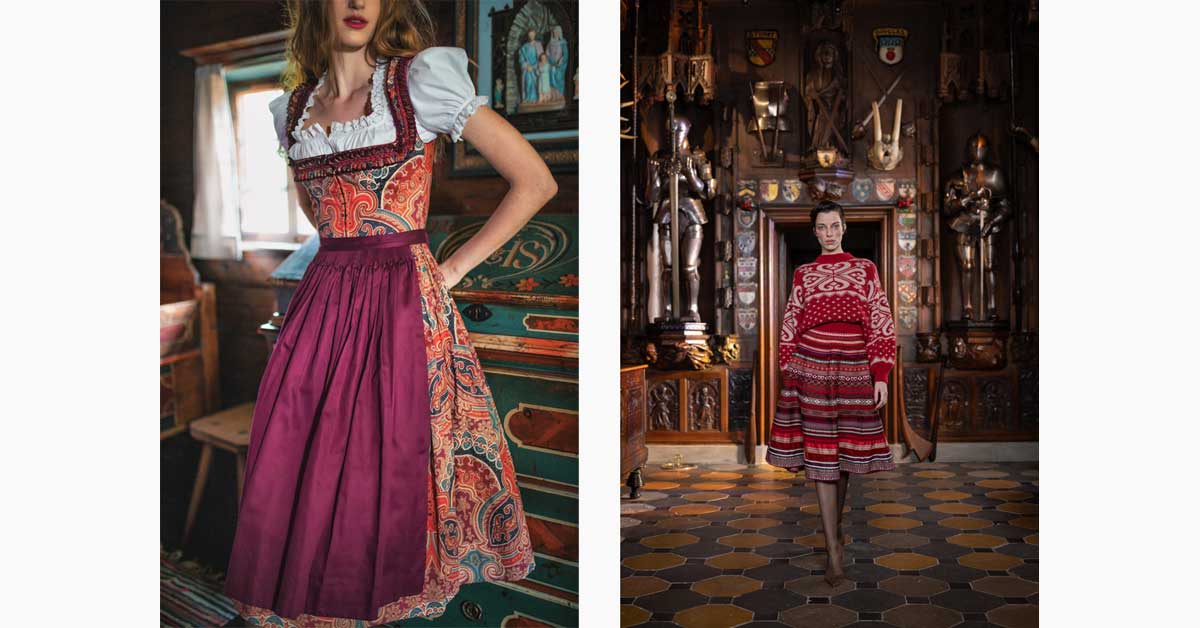

24 August 2024
 The Austrians are already in the starting blocks for the Oktoberfest and harvest festivals, which have already begun with the Kirtag events. It's popular to attend these events dressed in traditional attire, which for women usually consists of a dirndl, blouse and apron, and for men typically lederhosen with a shirt and jacket. More fashionable is the citation of the tracht with single pieces that also allow a more individual style, such as a trachten cardigan combined with wide-legged trousers or jeans, or a trachten skirt combined with a casual sweater or pullover, lederhosen with a t-shirt, or simply some accessories such as trachten jewelry to casual wear. In August, the decision on where the trend of the late summer, early fall season will go is presented by the specialists of the business in time with the drop of the collection pieces in the stores and online, such as the country's trachten specialist Lena Hoschek, who explores traditional clothing from a more global aspect and incorporates traditional clothing from other countries into the Central European alpine women's costume as it has developed over the last 500 years. In the Fall/Winter 2024/25 collection of the 'Tradition' line by Lena Hoschek, the designer explored the cultural history of Scotland, especially the rich history of textiles from tartans to Fair Isle and Paisley patterns. The latter got its name from the fact that the pattern, which is of Persian origin, was produced by weavers in Paisley, Scotland, from the early 1800s and made popular in the West from here. One of the highlights of the dirndl range in the new Tradition collection is a fabric featuring an interpretation of the classic Paisley pattern in vibrant red, orange, green, blue and cream. For the presentation of the collection, the dirndl is combined with a purple apron and a white blouse and placed in front of a rustic chest of drawers with colorfully painted floral patterns and a secretary attachment, most likely from the period when Austrian traditional costumes, such as the dirndl, became fashionable pieces for the urban population on their visits to the countryside around 1870. The driving force behind the trend in Austria was the aristocracy in the mid-19th century, especially the depictions of Emperor Franz Joseph I of Austria and his wife Empress Elisabeth of Austria, who were one of the most influential couples in Europe after their marriage in 1854. (Paintings showing the 'influencers' of their time in traditional rural clothing are published on emuseum.schoenbrunn-group.com/objects/90559/kaiser-franz-joseph-in-landlicher-tracht and emuseum.schoenbrunn-group.com/objects/90558/kaiserin-elisabeth-in-landlicher-tracht.) Another outfit recently unveiled in a press release shows a red and white knit sweater worn with the label's signature ribbon skirt. The pattern of the sweater is reminiscent of the knitting aesthetic of geometric and floral motifs strongly associated with the Fair Isle, one of the Shetland Islands in Scotland, where knitting has been practiced for several hundred years since the 17th century. The knitting technique became fashionable in the 1920s after the Prince of Wales, later King Edward VIII, later Duke of Windsor, wore a Fair Isle pullover. Images courtesy of Lena Hoschek: Pictured is the 'Aileen' paisley dirndl with purple apron and ivory 'St. Wolfgang' blouse from Lena Hoschek's Fall/Winter 2024/25 'Tradition' line. On the right: The 'Winnie' pullover in strawberry cream paired with the 'MacGregor' ribbon skirt. Photos by Aida Dapo/@iddavanmunster. Editor's note (literature with affiliate link): In addition to search engines and chatting with AI, the practical handbook (in German) 'Reclams Mode- und Kostümlexikon' by Ingrid Loschek was used by Fashion.at for historical facts about Austrian trachten and Scottish textile tradition. |